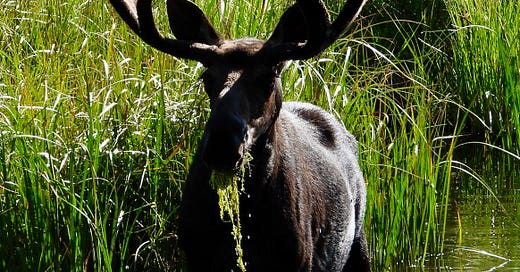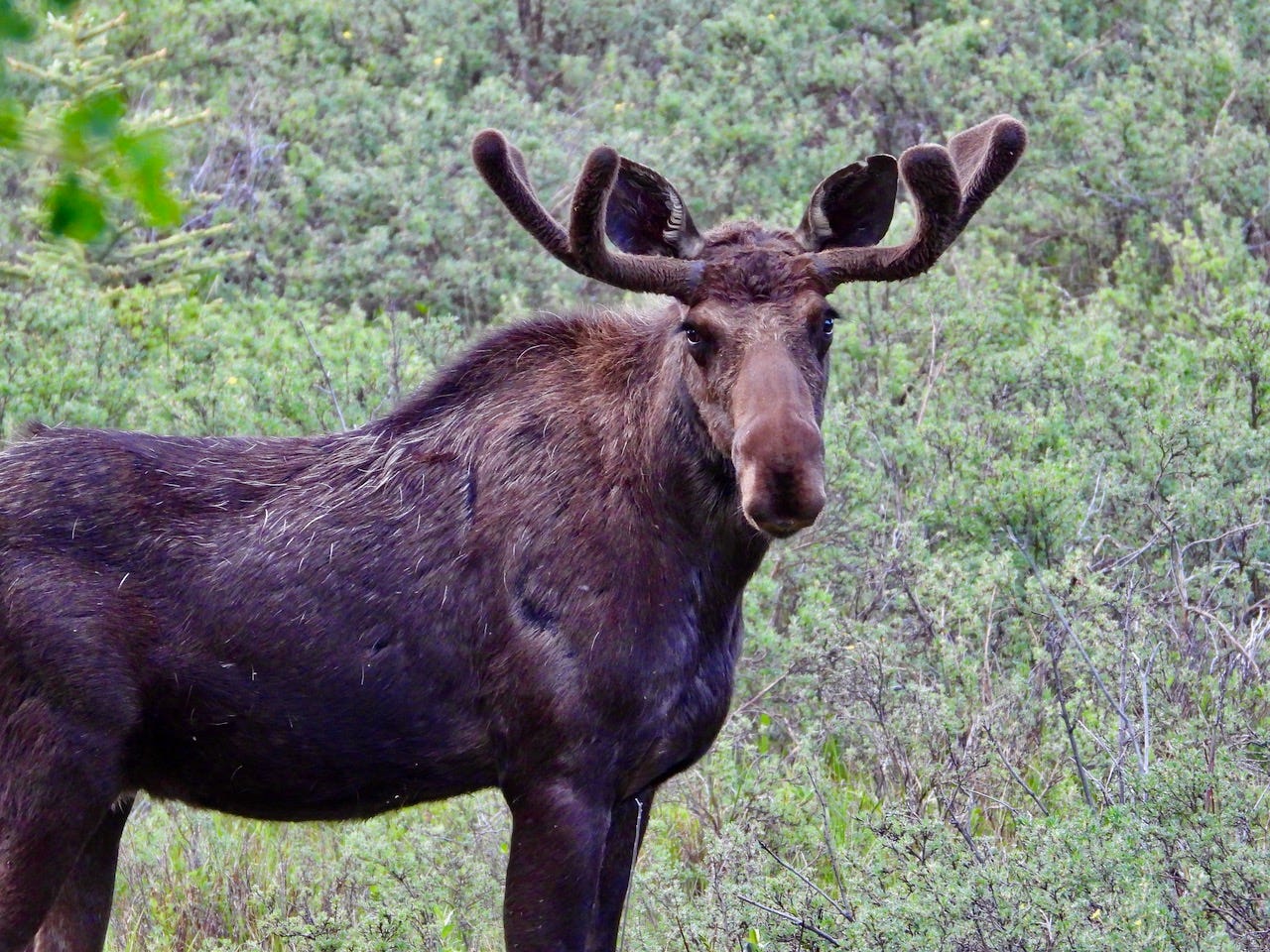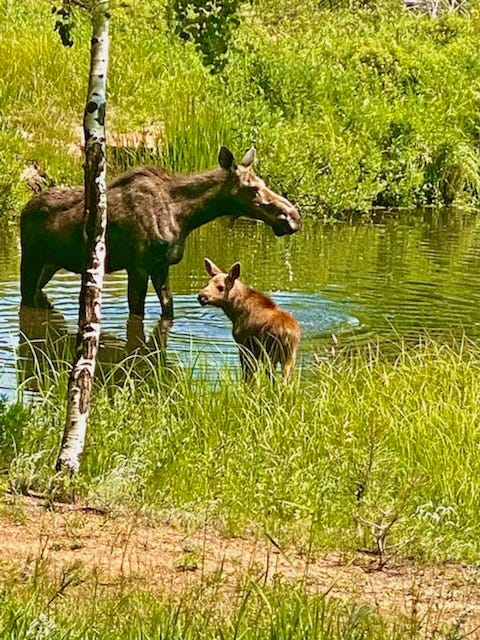MOOSE!
Shhhhhh! Come out on the deck very quietly. Grab the binoculars and camera. Keep the dog inside so she doesn’t bark. There’s a moose in the pond.
In at least the social media feeds that I follow, there are a great deal of moose pictures with calves of late, so it is a good time to revisit this post from July of 2023.
We are watching, from a safe distance, that huge head submerge fully, antlers and all, and then the cascade of water pouring off the antlers as he comes up with a mouthful of green aquatic plants from the pond floor. He munches and slurps up the green goo and goes down for another mouthful. Any floating algae get slurped up to top it off. Bruce the Moose is a good pond cleaning technician. We always appreciate it when he stops by.
The Moose diet is the vegetation in the wetlands, and they even get their name from the Algonquin ‘moosu’ and ‘moosh’ meaning ‘bark-stripper’ in the language of the Innu people of Quebec, Canada. The moose will chow over 10,000 calories per day of vegetation and will hold close to 100 lbs of food among its four stomachs at any given time. Like all browsing mammals, the moose is a non-stop eating machine. That algae he slurped up is an added boost of nutrients and salt to his diet.
In the pond, lake, or ocean shore, a moose can stay in the water quite a while and dive deep, even going 20 feet down. Uniquely equipped with nostrils that pinch shut and fur that is hollow like a polar bear’s, they can be fully submerged for a full minute, and their hollow fur will float them back to the surface. They can swim faster than an Olympic gold medalist, and their fur enables them to withstand frigid temperatures. This makes the moose ideal for life in places like Canada and Alaska. Broad two-toed feet with additional dewclaws make his massive frame nimble through deep snow and wetland marsh. Extreme cold does not bother them; in fact, researchers have tested moose down to -22°F, and moose do not need to take any additional measures, such as movement to generate heat energy, to warm themselves up. Their 4-stomach digestive system generates a great deal of internal heat. Summer is another matter. Even with a lighter, summer coat, a moose can overheat easily in temperatures above 60°F. A dunk in a deep mountain lake helps a lot, but with rising temperatures, their adaptations may not keep up with the changes to come. Their populations are climbing to higher, cooler elevations.
As residents of Alaska, Canada, and other countries near the Arctic Circle, what are they doing here in Colorado? Historical sightings going back to the 1850s show that moose would wander down from Wyoming into Colorado, but they didn’t tend to stick around. In 1978, following nearly 3 decades of study and public input, the Colorado Division of Wildlife transplanted 24 moose into the North Park area of Colorado, near Walden. By 2012, after four additional transplants of 12-90 moose each, that population grew to 2,300 moose throughout the higher, cooler, elevations. Today, their number is about 3,500. For comparison, though, there are nearly a million moose throughout Canada.
Seeing a moose is unmistakable; they are huge, often 6 feet tall at their shoulder. A bull moose with a full 6-foot antler rack, 70+ lbs on its own, can top 1600 lbs. While their eyesight is considered to be poor, their hearing, with massive omnidirectional ears, 60x larger than a human, is very acute.
Their antlers are a wonder. Through the spring, the antlers grow an inch (and conversely gain a pound) per day. Covered with velvet, this covering holds blood vessels feeding the rapid growth of the bone material. Up to 6 feet wide by the mating rut season in September, the antlers stop growing, and the velvet begins to peel off. Often a bloody mess of a sight, the moose will eat the nutrient-rich velvet as it sheds by rubbing it on trees, rocks, and shrubs. The bare bone then hardens into a mighty fighting weapon for the competition of the rut. The additional benefit of the wide plates of their antlers, is that they become a parabolic reflector, increasing their sound input by up to 20% as they listen for the cries of the cow moose to find them. To the mighty go the spoils of the rut. By November, the rut is over, and the antlers are no longer needed; they are quite a burden to go into winter with. The bone weakens, and the antlers are shed at some point between November and March. Lucky you if you find a shed antler. Otherwise, the antlers weather and break down in time, returning nutrients to the vegetation they eat. When spring comes, the antler growth begins again. Our local moose has visited several times over the recent weeks, and his antlers are noticeably larger each visit.
With the Autumn rut, the calves then arrive in late Spring. A single calf or, often, twins when food is abundant. This is the most dangerous time in a moose’s life. Nearly half of all calves fall to predators such as coyotes, wolves, bears, and mountain lions. Seemingly harsh, but an ecological balance with the predators feeding their own young and balancing populations. For those that survive this perilous time, their chance of a long, full, moosey life shoots up to 95% living out their 15-20 years.
A well-organized pack of coyotes, wolves, or even orcas! (See YouTube link in Sources) can take down an adult moose. But it is man that is the most effective predator of these huge creatures. Hunting moose has gone on for over 13,000 years and is an important part of the tribes and cultures of the northern climates. Moose are not currently endangered and are listed as ‘of least concern’ at this time.
Watching a moose is an amazing sight. But, getting mutually surprised by a moose can be a very dangerous moment, and it’s happening more frequently on the hiking trails of Colorado. Moose are normally quite docile until they feel a threat to themselves or, especially, their calf. Keeping dogs on a leash is the safest place for them. Too many dogs bark at and charge a moose only to be killed by the crushing weight of over 1,000 lbs on the hoof. If you find yourself within 50 feet or closer to a moose, don’t scream or run. Talk softly and back away. If the moose shows agitated behavior of neck and back hairs on end, ears back, snorting, or lip licking, move as quickly as possible to get something between you and the moose. A tree, furniture, a car, or getting inside a building is your safest bet. Keep your dog very close and quiet. In all honesty, I’d rather (and have) face a bear than an angry moose. (Well, the bear I met up with on a dog walk was a little black bear, far more afraid of me than I of him.)
If you live in the mountains or Foothills of Colorado, I hope you will get to see a moose at some point, from a safe distance. Rocky Mountain National Park has a notable population that is frequently sighted. Kenosha Pass and Hoosier Pass are good sighting spots as well. Remember, if you hold your thumb up and it covers the large animal (bison, elk, moose, bear, etc) then you are at a safe distance.
My very first encounter with a moose was on a Boundary Waters camping trip in Minnesota in the early 1980s. Something had spooked a mama and calf, and the two came crashing through my solo campsite early morning, running out into the lake. Had I been sitting even 5 feet over, I would have been clobbered. My young, naive self should have wondered more about what had spooked them, but I was too shocked to think of it. I’ll take watching them peacefully from my deck these days.
The Abert Essays is a labor of love, but each post takes research and writing time. Upgrading your subscription to paid supports my continuing posts and is very much appreciated. Thank you!
📷 All photos are credited: The Abert Essays unless otherwise noted. Yes, the moose shots are taken from our deck.
📱 Join me on my Facebook page, Substack Notes, and my new BlueSky page. I post smaller ‘Encounters’ posts there as I see flowers, animals, weather patterns, and anything else that catches my eye.
Sources:
https://cpw.state.co.us/documents/wildlifespecies/mammals/moosereintroductionfactsheet.pdf
- https://www.dec.ny.gov/docs/wildlife_pdf/moose1.pdf
- https://www.summitdaily.com/news/stolen-dewlaps-bells-dew-claws-and-moose-factoids/
- https://www.livescience.com/27408-moose.html
- Go figure, orcas!:
- https://www.nps.gov/articles/moose-did-you-know.htm
- https://en.wikipedia.org/wiki/Moose
- https://www.gov.mb.ca/nrnd/fish-wildlife/pubs/fish_wildlife/hard-to-be-a-moose.pdf









